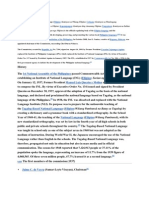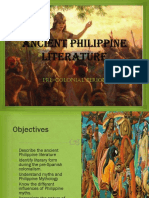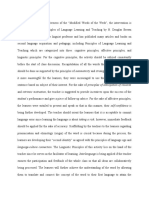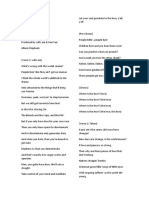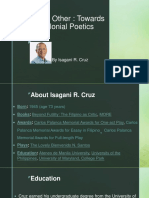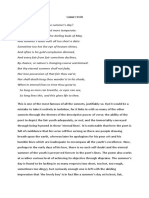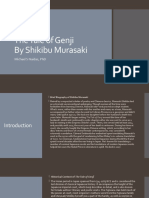Indian and Japanese Literature
Indian and Japanese Literature
Uploaded by
Joyce Ann Aquino SolimanCopyright:
Available Formats
Indian and Japanese Literature
Indian and Japanese Literature
Uploaded by
Joyce Ann Aquino SolimanOriginal Title
Copyright
Available Formats
Share this document
Did you find this document useful?
Is this content inappropriate?
Copyright:
Available Formats
Indian and Japanese Literature
Indian and Japanese Literature
Uploaded by
Joyce Ann Aquino SolimanCopyright:
Available Formats
INDIAN LITERATURE
Indian literature is generally believed to be the oldest in the world. With vast cultural diversities,
there are around two dozen officially recognized languages in India. Over thousands of years, huge
literature has been produced in various languages in India. It is to be noted that a large part of Indian
literature revolves around devotion, drama, poetry and songs. Sanskrit language dominated the
early Indian literary scene whereas languages like Prakrit and Pali too had fair share as they were
the languages of the common people. It is interesting to note that the Hindu literary traditions have
dominated a large part of Indian culture.
COMMON THEME IN INDIAN LITERATURE
Mythological - the first to capture and enchant Indian readers, dealing with kings, queens, palaces, demons,
gorgons, vision of heaven or hell, the Almighty, battles and ultimate winning, also including themes like
'never never land' and every sort of non-living thing being animated into a living being. Indeed, these
mythological stories had so very appealed and captivated Indian minds, that none of the succeeding
generations has ever been able to come out of this everlasting 'hypnotic' effect.
Example: The Dedication of Eklavya by Vyasa
Epic - defines and assays to portray the out and out influence and sway that the ancient literatures had on
the subsequent humanity and that which is still going on. The Epic Age can basically be attributed to the
times beginning from 1500 B.C. and culminating in 1200 A.D. Hence, before analysing the influence of epic
themes in Indian literature, it is first necessary to comprehend the times of Epic India and its culture and
customs.
Example: Ramayana by Valmiki, Mahabharata by Vyasa
Romantic - Romance necessarily entailed virtually every aspect of life dealing with war, battles, crusades,
chivalry, gallantry, relationships with heroic adventure and its knights wooing the princess etc and not only a
love affair between a male and a female. As is known from historical annals, literature in India, during its very
initiation, was essentially oral and delivered by the word of mouth.
Example: Beyond Oria Falls by Sheryl Seal, Beloved Savage by Sandra Bishop
https://www.indianetzone.com/39/themes_indian_literature.htm
CONTRIBUTION OF INDIAN LITERATURE TO THE WORLD
As India has grown in prominence on a world stage, so too have its writers. The 1990s and
2000s witnessed a dramatic boom in Indian writers working in English, while the study of India’s
many literary traditions has grown in strength in universities outside of India. Indian literary
studies offer promising angles for world literature. They bring an acute sensitivity to the
material conditions under which literature gains visibility in different parts of the world; an
acknowledgement of the usefulness of translation for legitimate scholarship, as used in literary
histories of India; an awareness of competing ideas of ‘worlding’ in different literary traditions,
as shown by emerging work on Hindi and Tamil; an attentiveness to histories of inequality and
oppression; and an increasing confidence that working within international or intercultural
systems does not necessarily eviscerate local connections.
https://www.eastasiaforum.org/2012/03/17/indian-literature-world-literature/
JAPANESE LITERATURE
spans a period of almost two millennia and comprises one of the major literatures in the world,
comparable to English literature in age and scope. It comprises a number of genres, including
novels, poetry, and drama, travelogues, personal diaries and collections of random thoughts and
impressions. From the early seventh century until the present there has never been a period
when literature was not being produced by Japanese authors. Japan adopted its writing system
from China, often using Chinese characters to represent Japanese words with similar phonetic
sounds. Early works were heavily influenced by cultural contact with China and Chinese
literature, and was often written in Classical Chinese.
https://www.newworldencyclopedia.org/entry/Japanese_literature
COMMON THEME IN JAPANESE LITERATURE
Patriarchy – it is commonly described as a system of social structures and practices, in which
men govern, oppress and exploit women.
Example: Kaguyahime (The Tale of the Bamboo Cutter) and Tsuru no Ongaeshi by Chihiro
Iwasaki
Loyalty - It is not uncommon for characters (whether completely fictional or based upon real
people) to discuss the concepts of loyalty to a master/lord, or to the nation as a whole. Many
today would most likely view loyalty as strong allegiance to (or faith in) a person, group, or idea.
Example: The Tale of the Heike
Obligation – also known as duty, responsibility, or a task or action that someone in required to
perform. It can be an obligation to your partner, family, boss, or friends.
Self-sacrifice - as the act of making human sacrifice, either voluntary or forced, is linked to the ritual
practice of the original mythological conscience, in which a sacrifice is regarded as the possibility of
removing certain peril threatening to endanger the survival of the community
Example: Ukigusa monogatari (A Story of Floating Weeds, 1932) by Yasujiro Ozu, Ugetsu (Tales of
Moonlight and Rain, 1953) by Ueda Akinari
https://factsanddetails.com/japan/cat20/sub128/item682.html
CONTRIBUTION OF JAPANESE LITERATURE TO THE WORLD
Japanese literature ranks as one of the major literatures of the world, comparable in
age, richness, and volume to English literature, though its course of development has
been quite dissimilar. The surviving works comprise a literary tradition extending from
the 7th century CE to the present; during all this time there was never a “dark age”
devoid of literary production. Not only do poetry, the novel, and the drama have long
histories in Japan, but some literary genres not so highly esteemed in other countries—
including diaries, travel accounts, and books of random thoughts—are also prominent. A
considerable body of writing by Japanese in the Chinese classical language, of much
greater bulk and importance than comparable Latin writings by Englishmen, testifies to
the Japanese literary indebtedness to China. Even the writings entirely
in Japanese present an extraordinary variety of styles, which cannot be explained
merely in terms of the natural evolution of the language.
https://www.britannica.com/art/Japanese-literature
You might also like
- The Cambridge History of Japanese Literature-Cambridge University Press (2016)Document868 pagesThe Cambridge History of Japanese Literature-Cambridge University Press (2016)Florencia100% (6)
- Bicolanos and IlocanosDocument1 pageBicolanos and IlocanosCJ San LuisNo ratings yet
- The Cow and The Carabao (Northern Luzon)Document11 pagesThe Cow and The Carabao (Northern Luzon)Arjelee Mae Cuestas50% (6)
- Affix ListDocument4 pagesAffix ListDoc AlexNo ratings yet
- Historical Controversy: The First Mass in The PhilippinesDocument64 pagesHistorical Controversy: The First Mass in The PhilippinesDeniell Kahlil Kyro GabonNo ratings yet
- Fundamentals of Reading Skills: Sir. EnzoDocument17 pagesFundamentals of Reading Skills: Sir. Enzojerico magalongNo ratings yet
- How My Brother Leon Brought Home A WifeDocument4 pagesHow My Brother Leon Brought Home A WifeJoanBangit100% (1)
- Statement of The ProblemDocument5 pagesStatement of The Problemloudivine villaNo ratings yet
- Paraphrasing ExercisesDocument4 pagesParaphrasing ExercisesJaveria salehNo ratings yet
- Figurative Language Unit TestDocument3 pagesFigurative Language Unit TestRamsha TjwNo ratings yet
- Forsaken HouseDocument6 pagesForsaken HouseCarolina BenaroNo ratings yet
- Filipino ResearchDocument19 pagesFilipino ResearchCleofe SamsonNo ratings yet
- Bathala:: Filipino MythologyDocument2 pagesBathala:: Filipino MythologySittie Zainab ManingcaraNo ratings yet
- Senior High School Department: Quarter 3 Module - 2 SEM - SY: 2021-2022Document12 pagesSenior High School Department: Quarter 3 Module - 2 SEM - SY: 2021-2022Jedidiah Daniel Lopez HerbillaNo ratings yet
- Vocabulary Difficulty and Learning Strategies of Grade 8-Special Science Class Students in Reading Afro-Asian Literary TextsDocument7 pagesVocabulary Difficulty and Learning Strategies of Grade 8-Special Science Class Students in Reading Afro-Asian Literary TextsDave FalculanNo ratings yet
- Module 7 2nd QuarterDocument71 pagesModule 7 2nd QuarterKim Joshua Guirre Daño100% (1)
- List of English Words of Philippine Origin WikipediaDocument2 pagesList of English Words of Philippine Origin WikipediaPaulAnthonyNo ratings yet
- Ancient Philippine LiteratureDocument17 pagesAncient Philippine LiteratureNoel Krish ZacalNo ratings yet
- Compilation of Pre-Colonial LiteratureDocument7 pagesCompilation of Pre-Colonial LiteratureCzai LavillaNo ratings yet
- A Broom Is SturDocument3 pagesA Broom Is SturMara MontonNo ratings yet
- Valenciana FestivalDocument2 pagesValenciana Festivaljavhen23No ratings yet
- Action Research Proposed InnovationDocument2 pagesAction Research Proposed InnovationRaymond TinduganNo ratings yet
- (Re) Framing Power in The Globalizing WorldDocument7 pages(Re) Framing Power in The Globalizing WorldJanice DollosaNo ratings yet
- Where Is The LoveDocument3 pagesWhere Is The LoveSergio M.No ratings yet
- The Story of ShakuntalaDocument4 pagesThe Story of ShakuntalaKukishin KrimNo ratings yet
- Aspects of Professional and Academic LanguageDocument50 pagesAspects of Professional and Academic LanguageChristian Grace CatipayNo ratings yet
- Hybrid English 4 Q2 M4 W4Document14 pagesHybrid English 4 Q2 M4 W4Jedasai PasambaNo ratings yet
- Reading and Revolution Objectives: To Give Knowledge About What Happened in The Past and How It Affects The Present. Introduction: ReadingDocument5 pagesReading and Revolution Objectives: To Give Knowledge About What Happened in The Past and How It Affects The Present. Introduction: ReadingMary Shine Magno MartinNo ratings yet
- Critical AnalysisDocument2 pagesCritical AnalysisnapakkamanbbenchNo ratings yet
- Lit 1 - Legends and PoemsDocument40 pagesLit 1 - Legends and PoemsJohn Jarrem PasolNo ratings yet
- Flash Fiction Rubric PDFDocument2 pagesFlash Fiction Rubric PDFMelody Velchez BumatayNo ratings yet
- Exposure VariablesDocument21 pagesExposure Variableszhareenali19No ratings yet
- Voice Tape PDFDocument14 pagesVoice Tape PDFAngeline Limbaga Trayfalgar75% (4)
- Husserlian Descriptive Phenomenology A Review of I PDFDocument7 pagesHusserlian Descriptive Phenomenology A Review of I PDFNg Shiu Hei LarryNo ratings yet
- Lecture 6 - Interview As A Communication ProcessDocument8 pagesLecture 6 - Interview As A Communication ProcessKevin MurdenNo ratings yet
- English 7 Reviewer 2nd QuarterDocument11 pagesEnglish 7 Reviewer 2nd Quarterlyronbrillantes1910No ratings yet
- Developing Love For ReadingDocument13 pagesDeveloping Love For ReadingCelestra JanineNo ratings yet
- PR2 4th Lesson July 31-Aug 4 PDFDocument38 pagesPR2 4th Lesson July 31-Aug 4 PDFFrida Faye LacsamanaNo ratings yet
- Grammatical ModelsDocument4 pagesGrammatical ModelsDesai Sinaca Elmido-FerolNo ratings yet
- Akeelah and The BeeDocument4 pagesAkeelah and The Beeapi-246969272No ratings yet
- Different Characteristics of Literature of Different Period of LiteratureDocument4 pagesDifferent Characteristics of Literature of Different Period of LiteratureKrystal Joy GarcesNo ratings yet
- Historical Background: Chapter 5: The American Regime (1898-1941)Document4 pagesHistorical Background: Chapter 5: The American Regime (1898-1941)Raquel LimboNo ratings yet
- Assertions 20 21 PDFDocument41 pagesAssertions 20 21 PDFRudy Pascual AquinoNo ratings yet
- An Analysis On The English Proficiency Among First Year Broadcasting Students of The Bulacan State University FinalDocument29 pagesAn Analysis On The English Proficiency Among First Year Broadcasting Students of The Bulacan State University FinalRaven FernandoNo ratings yet
- Critical ReadingDocument3 pagesCritical ReadingFrancis B. TatelNo ratings yet
- The Other Other: Towards Postcolonial Poetics: by Isagani R. CruzDocument10 pagesThe Other Other: Towards Postcolonial Poetics: by Isagani R. CruzRalph Bryell OlasoNo ratings yet
- Essay Format SampleDocument1 pageEssay Format SampleIsmail100% (1)
- History and Evolution of Major Agrarian Reform LawsDocument14 pagesHistory and Evolution of Major Agrarian Reform LawsanneNo ratings yet
- English As The Medium of Instruction For Science and Its Effects On The Languages of The PhilippinesDocument22 pagesEnglish As The Medium of Instruction For Science and Its Effects On The Languages of The PhilippinesMatt ChenNo ratings yet
- ImageryDocument12 pagesImagerysyafic1968No ratings yet
- BIBLIOGRAPHYDocument53 pagesBIBLIOGRAPHYrenerose maligNo ratings yet
- Close Analysis Bob OngDocument3 pagesClose Analysis Bob OngAlkallain Brands CompanyNo ratings yet
- Advanced Academic Reading and WritingDocument5 pagesAdvanced Academic Reading and WritingAhmad NawazNo ratings yet
- Local Authors and Their WorksDocument16 pagesLocal Authors and Their WorksJohn Wayne LaynesaNo ratings yet
- Canonical Authors: That Exposed The Ills of The Society.)Document3 pagesCanonical Authors: That Exposed The Ills of The Society.)Kimberley Sicat BautistaNo ratings yet
- Acrolect Mesolect BasilectDocument5 pagesAcrolect Mesolect BasilectbtchonmydeckNo ratings yet
- Teaching Oral Communication SkillsDocument18 pagesTeaching Oral Communication SkillsRuth N. Puente100% (1)
- 3445 8085 1 PBDocument12 pages3445 8085 1 PBChris RosalesNo ratings yet
- The Case for Masks: Science-Based Advice for Living During the Coronavirus PandemicFrom EverandThe Case for Masks: Science-Based Advice for Living During the Coronavirus PandemicNo ratings yet
- PrepScholar SOP Sample One PDFDocument2 pagesPrepScholar SOP Sample One PDFGoutham RangarajanNo ratings yet
- Contemporary Japanese WritersDocument2 pagesContemporary Japanese WritersCHETACONCHETANo ratings yet
- Sonnet XviiiDocument18 pagesSonnet XviiiApril SacupayoNo ratings yet
- Otaku ListDocument6 pagesOtaku ListJohn Manea100% (1)
- 21st ReviewerDocument16 pages21st Reviewercharlesferrer718No ratings yet
- Lesson 10 - Week 2 PerdevDocument15 pagesLesson 10 - Week 2 PerdevChristian OconNo ratings yet
- Manga Draw Quyty2013 0225 PDFDocument222 pagesManga Draw Quyty2013 0225 PDFAndre Luis A-myu20% (5)
- Comics Dream Works Vol 01Document234 pagesComics Dream Works Vol 01Tsubaki Star50% (2)
- MGDDocument256 pagesMGDakumaNo ratings yet
- Hokku PDFDocument8 pagesHokku PDFMichal SlavNo ratings yet
- 21st Century Literature Q2 Weeks 3 4Document14 pages21st Century Literature Q2 Weeks 3 4Dave Angelo GuillarteNo ratings yet
- Japanese PoetryDocument39 pagesJapanese PoetrySha Jijan100% (1)
- HaikuDocument11 pagesHaikuSherman BhanaNo ratings yet
- NarutoDocument5 pagesNarutocharles111111No ratings yet
- Reflection Paper - Japan LitDocument2 pagesReflection Paper - Japan LitAlexis FortunatoNo ratings yet
- Mutsua Basho - Ancient PoemsDocument3 pagesMutsua Basho - Ancient PoemsJaydev PadhNo ratings yet
- How To Draw Animation Fineartvn Blogspot ComDocument71 pagesHow To Draw Animation Fineartvn Blogspot ComAtos Pdfcrew100% (1)
- Angel ToooDocument5 pagesAngel ToooEjaselleNo ratings yet
- Usporedba Motiva Opsesije Slikara U Novelama "Tetoviranje" Tanizakija Jun'Ichira I "Lud Slikar" Kima Dong-InaDocument33 pagesUsporedba Motiva Opsesije Slikara U Novelama "Tetoviranje" Tanizakija Jun'Ichira I "Lud Slikar" Kima Dong-InaTwister X SanNo ratings yet
- Tanaka Sensei JapLit 2Document11 pagesTanaka Sensei JapLit 2Royce Mae CarampatanNo ratings yet
- A Brief History of HaikuDocument2 pagesA Brief History of HaikuNoel Krish ZacalNo ratings yet
- The Tale of Genji by Shikibu Murasaki: Michael S Naidas, PHDDocument21 pagesThe Tale of Genji by Shikibu Murasaki: Michael S Naidas, PHDjohnpenielmontales100% (1)
- The WallflowerDocument3 pagesThe WallflowerezealandNo ratings yet
- Japanese LiteratureDocument2 pagesJapanese LiteratureLizzette ApondarNo ratings yet
- Manga - Draw - Quyty2013 - 0296 PDFDocument115 pagesManga - Draw - Quyty2013 - 0296 PDFandrelvo33% (6)
- 21st Century Phil LitDocument26 pages21st Century Phil LitMary Joan PenosaNo ratings yet
- Japanese LiteratureDocument10 pagesJapanese Literaturep.volitans100% (2)
- Japan LiteratureDocument9 pagesJapan LiteratureJazzd Sy GregorioNo ratings yet
- JRR1 PreviewDocument17 pagesJRR1 PreviewJRR1No ratings yet











